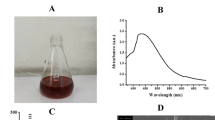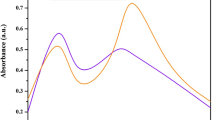Abstract
The synthesis of silver nanoparticles (AgNPs) using Annona muricata (A. muricata) leaf extract and its larvicidal, metabolic enzyme inhibitory properties was demonstrated here. The AgNPs were synthesized and analyzed by using UV-visible spectroscopy and observed a maximum absorbance peak at 420 nm which corresponds to the AgNPs. The XRD analysis showed the 2θ intense values (111, 200, 220, and 311) within the ranges of Bragg’s reflection; Fourier transform infrared spectroscopy (FTIR) showed that AgNPs were capped with alkanes, amides, and alkenes functional groups which act as a reducing, capping, and stabilizing agent; and field emission scanning electron microscope (FESEM) and high-resolution transmission electron microscopy (HRTEM) results indicated that synthesized AgNPs were spherical in shape with the size of 20–34 nm and energy-dispersive X-ray (EDX) spectroscopy exhibited a strong signal of silver. Various concentrations of AgNPs (6, 12, 18, 24, 30 μg mL−1) and aqueous leaf extract (ALE) (30, 60, 90, 120, 150 μg mL−1) were evaluated, and in all the concentrations, AgNPs showed significant larvicidal properties against three different second instar larvae, when compared to ALE. ALE exhibited LC50 and LC90 values of (LC50 45.521 μg/mL; LC90 456.406 μg/mL) against Ae. aegypti followed by An. stephensi (LC50 61.878 μg/mL; LC90 565.309 μg/mL) and Cx. quinquefasciatus (LC50 68.952 μg/mL; LC90 444.512 μg/mL), and AgNPs were exhibited LC50 and LC90 values (LC50 3.089 μg/mL; LC90 18.467 μg/mL) against Ae. aegypti followed by An. stephensi (LC50 3.155 μg/mL; LC90 39.888 μg/mL) and Cx. quinquefasciatus (LC50 5.188 μg/mL; LC90 31.660 μg/mL), respectively. The A. muricata leaf extract-mediated AgNPs were also evaluated for the first time to identify their metabolic enzyme inhibitory activity which also showed significant results.













Similar content being viewed by others
References
Abdel-Raouf, N., Al-Enazi, N. M., & Ibraheem, I. B. M. (2017). Green biosynthesis of gold nanoparticles using Galaxaura elongata and characterization of their antibacterial activity. Arabian Journal of Chemistry, 10, S3029–S3039. https://doi.org/10.1016/j.arabjc.2013.11.044.
Ankamwar B, Damle C, Ahmad A, Sastry M (2005) Biosynthesis of gold and silver nanoparticles using Emblica Officinalis fruit extract,their phase transfer and transmetallation in an organic solution. 5:1665–1671. https://doi.org/10.1166/jnn.2005.184
Artanti AN, Astirin OP, Prayitno A (2016). Cytotoxic Activity Of Non Polar Fraction From Annona Muricata L. Leaves On Hela And Raji Cell Line. Journal of Pharmaceutical Science and Clinical Research, 01, 112 – 118. https://doi.org/10.20961/jpscr.v1i2.1944.
Ayala-núñez NV, Villegas HHL, Ixtepan C, Padilla CR (2009) Silver nanoparticles toxicity and bactericidal effect against methicillin-resistant Staphylococcus aureus: Nanoscale does matter. 2–9. https://doi.org/10.1007/s12030-009-9029-1
Behravan, M., Hossein, A., Naghizadeh, A., et al. (2019). International journal of biological macromolecules facile green synthesis of silver nanoparticles using Berberis vulgaris leaf and root aqueous extract and its antibacterial activity. International Journal of Biological Macromolecules, 124, 148–154. https://doi.org/10.1016/j.ijbiomac.2018.11.101.
Bhabha, M., Roy, M., Mandal, B., et al. (2008). Green synthesis of highly stabilized nanocrystalline silver particles by a non- pathogenic and agriculturally important fungus T. asperellum. https://doi.org/10.1088/0957-4484/19/7/075103.
Cetin, H., Erler, F., & Yanikoglu, A. (2004). Larvicidal activity of a botanical natural product, AkseBio2, against Culex pipiens., 75, 724–728. https://doi.org/10.1016/j.fitote.2004.09.003.
Cijo, G. V., Naveen Kumar, D. R., & Suresh KumarP, K. A. R. (2014). Antioxidant, DNA protective efficacy and HPLC analysis of Annona muricata (soursop) extracts. Journal of Food Science and Technology. https://doi.org/10.1007/s13197-014-1289-7.
Hardoko, H., & Wijoyo, S. (2015). In vitro antidiabetic activity of “green tea” soursop leaves brew through α-glucosidase inhibition. International Journal of PharmTech Research, 8, 30–37.
Hilgenbrink, A. R., & Low, P. S. (2005). Folate receptor-mediated drug targeting: From therapeutics to diagnostics., 94, 2135–2146. https://doi.org/10.1002/jps.20457.
Kamaraj, C., Bagavan, A., & Rahuman, A. A. (2009). Larvicidal potential of medicinal plant extracts against Anopheles subpictus Grassi and Culex tritaeniorhynchus Giles (Diptera: Culicidae). Parasitology Research, 1163–1171. https://doi.org/10.1007/s00436-008-1306-8.
Kingsley, J. D., Dou, H., Morehead, J., et al. (2006). Nanotechnology: A focus on nanoparticles as a drug delivery system, 340–350. https://doi.org/10.1007/s11481-006-9032-4.
Kowshik, M., Ashtaputre, S., Kharrazi, S., & KM P. (2003). Extracellular synthesis of silver nanoparticles by a silver-tolerant yeast strain MKY3. Nanotechnology, 95, 95–100.
Levard, C., Hotze, E. M., Lowry, G. V., & Brown, G. E. (2012). Environmental transformations of silver nanoparticles: Impact on stability and toxicity. Environmental Science & Technology, 46, 6900–6914. https://doi.org/10.1021/es2037405.
Liu, Y., Si, M., Lu, W., et al. (2015). Effects and molecular mechanisms of the antidiabetic fraction of Acorus calamus L. on GLP-1 expression and secretion in vivo and in vitro. Journal of Ethnopharmacology. https://doi.org/10.1016/j.jep.2015.03.014.
Malapermal, V., Botha, I., Babu, S., et al. (2015). Enhancing antidiabetic and antimicrobial performance of Ocimum basilicum, and Ocimum sanctum (L.) using silver nanoparticles. Saudi Journal of Biological Sciences. https://doi.org/10.1016/j.sjbs.2015.06.026.
Matsui, T., Ueda, T., Oki, T., et al. (2001). r -Glucosidase inhibitory action of natural acylated anthocyanins. 1. survey of natural pigments with potent inhibitory activity. Journal of Agricultural and Food Chemistry, 49, 1948–1951.
Mehmood, A., Murtaza, G., Bhatti, T. M., & Kausar, R. (2017). Phyto-mediated synthesis of silver nanoparticles from Melia azedarach L. leaf extract: Characterization and antibacterial activity. Arabian Journal of Chemistry, 10, S3048–S3053. https://doi.org/10.1016/j.arabjc.2013.11.046.
Miguel, Bobadilla, Zavala, & Sisniegas, M. (2005). Larvicidal evaluation of aqueous suspensions of Annona muricata Linnaeus (custard apple) against Aedes aegypti Linnaeus (Diptera, Culicidae). Revista Peruana de Biología, 12, 145–152.
Mulvaney, P. (1996). Surface plasmon spectroscopy of nanosized metal particles. Langmuir, 788–800. https://doi.org/10.1021/la9502711.
Murugan, K., Aamina, M., Panneerselvam, C., et al. (2015). Research in veterinary science Aristolochia indica green-synthesized silver nanoparticles: A sustainable control tool against the malaria vector Anopheles stephensi? YRVSC, 102, 127–135. https://doi.org/10.1016/j.rvsc.2015.08.001.
Narducci, D. (2007). An introduction to nanotechnologies: What _ s in it for us?, 31, 131–137. https://doi.org/10.1007/s11259-007-0082-8.
Omri abdelwahab Suntres, Z., Mozafari, M. R., & Azghani, A. L. I. (2007). Chapter 3 artificial implants – new developments and associated problems. In Nanomaterials and nanosystems for biomedical applications (pp. 53–54).
Padalia, H., Moteriya, P., & Chanda, S. (2015). Green synthesis of silver nanoparticles from marigold flower and its synergistic antimicrobial potential. Arabian Journal of Chemistry, 8, 732–741. https://doi.org/10.1016/j.arabjc.2014.11.015.
Padma, P., Pramod, N. P., Thyagarajan, S. P., & Khosa, R. L. (1998). Effect of the extract of Annona muricata and Petunia nyctaginiflora on Herpes simplex virus. Journal of Ethnopharmacology, 61, 81–83. https://doi.org/10.1016/S0378-8741(98)00013-0.
Parthiban, E., Manivannan, N., Ramanibai, R., & Mathivanan, N. (2018). Green synthesis of silver-nanoparticles from Annona reticulata leaves aqueous extract and its mosquito larvicidal and anti-microbial activity on human pathogens. Biotechnology Reports, 20, e00297. https://doi.org/10.1016/j.btre.2018.e00297.
Parveen, M., Ahmad, F., Mohammed, A., & Shaista, M. (2015). Microwave-assisted green synthesis of silver nanoparticles from Fraxinus excelsior leaf extract and its antioxidant assay. https://doi.org/10.1007/s13204-015-0433-7.
Patil, C. D., Borase, H. P., Patil, S. V., et al. (2012). Larvicidal activity of silver nanoparticles synthesized using Pergularia daemia plant latex against Aedes aegypti and Anopheles stephensi and nontarget fish Poecilia reticulata. Parasitology Research, 111, 555–562. https://doi.org/10.1007/s00436-012-2867-0.
Philip, D. (2009). Biosynthesis of Au, Ag and Au – Ag nanoparticles using edible mushroom extract. Spectrochimica Acta Part A: Molecular and Biomolecular Spectroscopy, 73, 374–381. https://doi.org/10.1016/j.saa.2009.02.037.
Roy, N., & Barik, A. (2010). Green synthesis of silver nanoparticles from the unexploited weed resources. International Journal of Nanotechnology and Application, 4, 95–101.
Sakulnarmrat, K., & Konczak, I. (2012). Composition of native Australian herbs polyphenolic-rich fractions and in vitro inhibitory activities against key enzymes relevant to metabolic syndrome. Food Chemistry, 134, 1011–1019. https://doi.org/10.1016/j.foodchem.2012.02.217.
Salem, W. M., Haridy, M., Sayed, W. F., & Hassan, N. H. (2014). Antibacterial activity of silver nanoparticles synthesized from latex and leaf extracts of Ficus sycomorus Antibacterial activity of silver nanoparticles synthesized from latex and leaf extract of Ficus sycomorus. Industrial Crops and Products, 62, 228–234. https://doi.org/10.1016/j.indcrop.2014.08.030.
Sari, H. N., Harahap, U., & Dalimunthe, A. (2013). Antimalarial activities extract of N-hexane, ethyl acetate and ethanol of soursop leaf (Annona muricata L) on mice (Mus musculus) infected with Plasmodium berghei. Journal of Innovations in Pharmaceutical and Biological Sciences, 6, 15–17.
Shankar, S. S., Ahmad, A., & Sastry, M. (2003). Geranium leaf assisted biosynthesis of silver nanoparticles. Biotechnology Progress, 19, 1627–1631.
Sharma, P., Mohan, L., & Srivastava, C. N. (2009). Amaranthus oleracea and Euphorbia hirta: natural potential larvicidal agents against the urban Indian malaria vector, Anopheles stephensi Liston (Diptera: Culicidae), 171–176. https://doi.org/10.1007/s00436-009-1644-1.
Sheliya, M. A., Begum, R., & Pillai, K. K. (2016). In vitro α - glucosidase and α - amylase inhibition by aqueous, hydroalcoholic, and alcoholic extract of Euphorbia hirta L. Drug Design, Development and Therapy, 7, 26–30. https://doi.org/10.4103/2394-6555.180156.
Tan, Y., & Chang, S. K. C. (2017). Digestive enzyme inhibition activity of the phenolic substances in selected fruits, vegetables and tea as compared to black legumes. Journal of Functional Foods. https://doi.org/10.1016/j.jff.2017.04.005.
Thilagam, Tamilselvan, & Chandrasekaran, R. (2013). Phytosynthesis of silver nanoparticles using medicinal and dye yielding plant of Bixa orellana L. leaf extract. Journal of Pharmaceutical and Scientific Innovation, 2, 9–13. https://doi.org/10.7897/2277-4572.02441.
Vanaja, M., & Annadurai, G. (2013). Coleus aromaticus leaf extract mediated synthesis of silver nanoparticles and its bactericidal activity. Applied Nanoscience, 3, 217–223. https://doi.org/10.1007/s13204-012-0121-9.
Vijayameena C, Subhashini G, Loganayagi M, Ramesh B (2013) Original research article phytochemical screening and assessment of antibacterial activity for the bioactive compounds in Annona muricata. International journal of current microbiology and applied sciences 2:1–8.
Warluji, R., Damodhar, V., & Balaso, S. (2014). Photosensitized synthesis of silver nanoparticles using Withania somnifera leaf powder and silver nitrate. Journal of Photochemistry and Photobiology B: Biology, 132, 45–55. https://doi.org/10.1016/j.jphotobiol.2014.02.001.
WHO (2017) Diabetes Fact Sheet. In: WHO 2017. http://www.who.int/news-room/fact-sheets/detail/diabetes/
WHO (2018a) Malaria. https://www.who.int/malaria/media/world-malaria-report-2018/en/
WHO (2018b) WHO 2018. In: WHO DIABETES. https://www.who.int/diabetes/global-report/en/
WHO 2018 (2018a) Dengue WHO 2018. https://www.who.int/denguecontrol/disease/en/
WHO 2018 (2018b) FILARIASIS. https://www.who.int/lymphatic_filariasis/managing-morbidity/en/
Wintachai, P., Paosen, S., & Takahashi, C. (2019). Microbial pathogenesis silver nanoparticles synthesized with Eucalyptus critriodora ethanol leaf extract stimulate antibacterial activity against clinically multidrug-resistant Acinetobacter baumannii isolated from pneumonia patients. Microbial Pathogenesis, 126, 245–257. https://doi.org/10.1016/j.micpath.2018.11.018.
Zafar, S., Ashraf, A., Ashraf, M. Y., et al. (2018). Preparation of eco-friendly antibacterial silver nanoparticles from leaf preparation of eco-friendly antibacterial silver nanoparticles from leaf extract of Ficus benjamina. https://doi.org/10.26717/BJSTR.2018.09.001829.
Zoubiri, S., & Chamouni, N. (2014). Chemical composition and larvicidal activity of Algerian Foeniculum vulgare seed essential oil. Arabian Journal of Chemistry, 7, 480–485. https://doi.org/10.1016/j.arabjc.2010.11.006.
Acknowledgments
We would like to thank the Department of Pharmaceutical Chemistry, JSS College of Pharmacy, Ooty, and the Department of Biotechnology, Periyar University, Salem, to carry out the studies.
Author information
Authors and Affiliations
Contributions
Dr. M.J.N. Chandrasekar, Dr. M.J. Nanjan, and Dr. D. Natarjan conceptualized and developed the idea of the research work. S. B. Santhosh along with Dr. B. Gayathri, Kaviarsan. L, P.Naresh, and P. Deepak collected the data and performed the research work. All the eight were involved in the interpretation of the data and in critical revision of the manuscript preparation. The final approval and accountability rests with Dr. M.J.N. Chandrasekar and Dr. D. Natarjan.
Corresponding authors
Ethics declarations
Conflict of Interests
The authors declare that they have no conflict of interest.
Additional information
Publisher’s Note
Springer Nature remains neutral with regard to jurisdictional claims in published maps and institutional affiliations.
Rights and permissions
About this article
Cite this article
Santhosh, S.B., Natarajan, D., Deepak, P. et al. Metabolic Enzyme Inhibitory and Larvicidal Activity of Biosynthesized and Heat Stabilized Silver Nanoparticles Using Annona muricata Leaf Extract. BioNanoSci. 10, 267–278 (2020). https://doi.org/10.1007/s12668-019-00709-w
Published:
Issue Date:
DOI: https://doi.org/10.1007/s12668-019-00709-w




